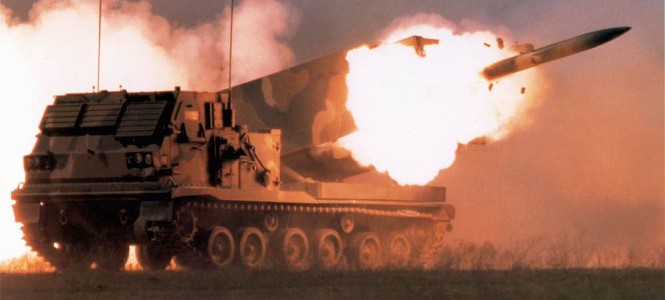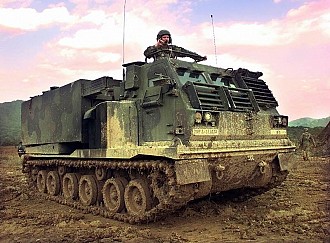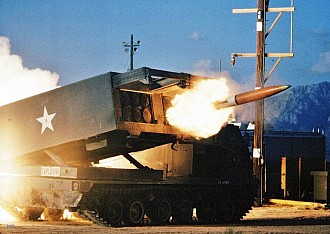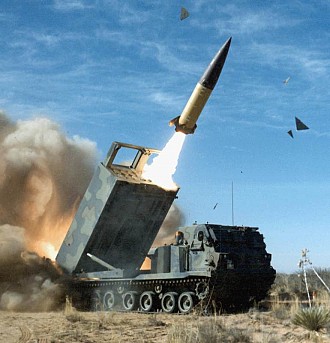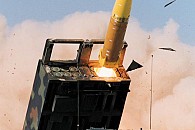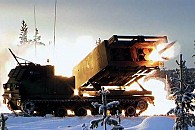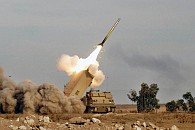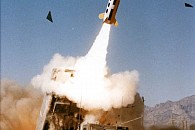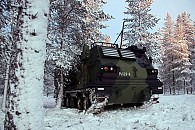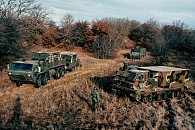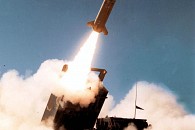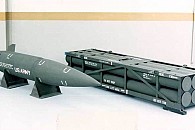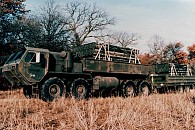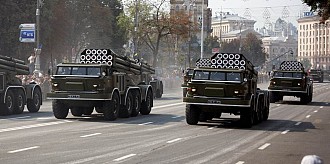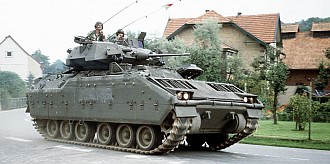Artillery / Multiple rocket launchers / MLRS
MLRS
General Facts
- TYPE
Multiple rocket launcher - ORIGIN
 United States
United States - NICKNAMES
M270 (US service)
298 RsRakH (Finnish service)
LRM / Lance-Roquettes Multiples (French service)
MARS / Mittleres Artillerie Raketen System (German service)
Menatetz (Israeli service) - DESIGNED
1977 - DESIGNER
Vought Corporation - PRODUCTION
1980 - 2003 - PRODUCERS
 Germany - Diehl
Germany - Diehl
 United States - Lockheed Martin
United States - Lockheed Martin - QUANTITY
About 1.300 launchers and over 700.000 rockets produced - UNIT COST
About $ 2.3 million per launch unit
About $ 100.000 per ATACMS missile - CHARACTERISTICS
 Long range and good accuracy
Long range and good accuracy
 Variety of rocket types available
Variety of rocket types available
 Good all terrain mobility
Good all terrain mobility
 Operated under armor
Operated under armor
 Small crew
Small crew
 Large and heavy
Large and heavy
 Expensive
Expensive
Introduction
The MLRS is a multiple rocket launcher of US origin. It was developed in the late 1970's to meet a joint US, UK, German and French requirement. The name MLRS stands for Multiple Launch Rocket System.
Layout
The MLRS is based on a tracked chassis with a forward control cab that houses the crew of three. The trainable launcher is mounted at the rear and is loaded by two blocks of rockets. Each block contains six unguided or guided solid fuel rockets or a single ATACMS missile. Additional ammunition is carried on all terrain trucks, such as the US HEMTT.
Firepower
The standard 227mm unguided rockets have a 32 km range and feature dual purpose submunitions. Extended range rockets have a 45 km range. Guided rockets are available with submunition or unitary warhead and with ranges of 60 or 90 km. Optionally two ATACMS missiles are carried which have a 300 km range.
Protection
The MLRS is operated and reloaded from under full armor protection. The armor protects the crew from small arms fire, shell splinters and the launch blast. NBC protection is standard.
Mobility
The tracked chassis provides a good off road capability and reasonable road speeds at 64 km/h. A 500 hp turbo diesel provides propulsion. The size and weight makes that the MLRS can only be transported by air in tactical airlift systems.
Users
The main user of the MLRS is the United States. It was adopted by a variety of European nations and various other US allies worldwide. Many systems in Western service have been adopted to launch the newer guided rockets. The MLRS system is being supplemented by the newer and more mobile HIMARS system.
M270 launch vehicle
The MLRS uses a track launch vehicle with a chassis derived from the M2 Bradley mechanized infantry combat vehicle. The launch vehicle may load two MFOM packs with either six 227mm rockets or a single ATACMS missile.
M270: Original MLRS system with 4 minute reload time.
M270A1: Improved MLRS system with reload time decreased to 3 minutes.
- Specifications:
- MLRS
| Type | Multiple rocket launcher |
|---|---|
| Crew | 3 |
| Length | 6.97 m |
| Width | 2.97 m |
| Height | 2.62 m (travelling), 5.93 m (launcher raised) |
| Ground clearance | 0.43 m |
| Weight | 20.2 t empty, 25.2 t combat load |
| Ground pressure | ? |
| Wheelbase | Tracked chassis, 6 roadwheels, drive sprocket front, idler rear, 4.33 m length, 0.53 m width |
| Turn radius | ? |
| Engine | Cummins VTA-903 8-cylinder diesel, 500 hp at 2.400 rpm |
| Power ratio | 19.8 hp/t |
|---|---|
| Transmission | ? |
| Speed | 64 km/h |
| Fuel | 617 L |
| Range | 480 km |
| Wall | 1 m |
| Trench | 2.3 m |
| Gradient | 60% gradient, 40% slope |
| Fording | 1.1 m |
| Armor | ? |
| NBC equipment | Yes |
| Night vision | ? |
|---|---|
| Smoke | No |
| Remarks | - |
| Armament | MFOM rocket launcher (2x) |
| Weapon1 | MFOM rocket launcher 12x 227mm rocket or 2x ATACMS |
| Weapon2 | - |
| Weapon3 | - |
| Weapon4 | - |
| Weapon5 | - |
| Weapon6 | - |
MFOM
The MLRS may fire the MFOM series of artillery rockets. MFOM stands for MLRS Family Of Munition. The MFOM reload containers carry six 227mm rockets or a single ATACMS missile.
M26: Original standard multi-purpose rocket with 644 M77 Dual-Purpose Improved Conventional Munitions (DPICM) sub-munitions.
M26A1: Improved multi-purpose rocket with M85 submunitions and longer range.
M26A2: M26A1 using the older M77 submunitions.
M30: Guided MLRS (GMLRS) with GPS guidance, further increased range and 404 M85 submunitions.
M31: Guided MLRS with unitary HE explosive warhead to reduce collateral damage.
AT2: European development with 28 scatterable anti-tank mines.
M27: Fully inert training pod.
M28: Practice rocket based on M26. Carries smoke markers instead of submunitions.
M28A1: Reduce range practice rocket with 9 km range.
| Type | Artillery rocket |
|---|---|
| Diameter | 227 mm body |
| Length | 3.937 m |
| Weight | 306 kg |
| Guidance | Unguided, ballistic flight |
|---|---|
| Warhead | 156 kg with 644 M77 submunitions |
| Propulsion | Solid propellant rocket motor |
| Speed | ? |
| Range | 31.6 km |
|---|---|
| Altitude | - |
| Engagement envelope | - |
| Remarks | - |
| Type | Artillery rocket |
|---|---|
| Diameter | 227 mm body |
| Length | 3.937 m |
| Weight | 296 kg |
| Guidance | Unguided, ballistic flight |
|---|---|
| Warhead | 518 M85 submunitions |
| Propulsion | Solid propellant rocket motor |
| Speed | ? |
| Range | 45.5 km |
|---|---|
| Altitude | - |
| Engagement envelope | - |
| Remarks | - |
| Type | Artillery rocket |
|---|---|
| Diameter | 227 mm body |
| Length | 3.937 m |
| Weight | 302 kg |
| Guidance | Guided, GPS navigation |
|---|---|
| Warhead | 404 M85 submunitions |
| Propulsion | Solid propellant rocket motor |
| Speed | ? |
| Range | over 60 km |
|---|---|
| Altitude | - |
| Engagement envelope | - |
| Remarks | 10 m CEP |
| Type | Artillery rocket |
|---|---|
| Diameter | 227 mm body |
| Length | 3.937 m |
| Weight | ? |
| Guidance | Guided, GPS navigation |
|---|---|
| Warhead | >90 kg HE unitary warhead |
| Propulsion | Solid propellant rocket motor |
| Speed | ? |
| Range | over 60 km |
|---|---|
| Altitude | - |
| Engagement envelope | - |
| Remarks | 2 m CEP |
| Type | Artillery rocket |
|---|---|
| Diameter | 227 mm body |
| Length | 3.935 m |
| Weight | 258 kg |
| Guidance | Unguided, ballistic flight |
|---|---|
| Warhead | 108 kg with 28 AT2 anti-tank mines |
| Propulsion | Solid propellant rocket motor |
| Speed | ? |
| Range | 39 km |
|---|---|
| Altitude | - |
| Engagement envelope | - |
| Remarks | 2 km by 115 m minefield with 12 rockets |
ATACMS
The Army Tactical Missile System (ATACMS) missiles are large solid fuel missiles with a much longer range and larger payload than the 227mm models. A M39 pack with single ATACMS can be loaded instead of a normal MFOM pack with six 227mm rockets.
MGM-140A ATACMS Block I: Original model with 165 km range, inertial navigation and 950 M74 anti-personnel and anti-materiel (APAM) grenades.
MGM-140B ATACMS Block IA: Extended range model with 300 km with GPS guidance and range reduced payload of 275 M74 APAM grenades.
MGM-164A ATACMS Block II: Extended range model with 13 Brilliant Anti-Tank (BAT) guided submunitions. Was briefly known as MGM-140C, with improved Block IIA model named MGM-140D. The BAT program was cancelled in 2003.
MGM-168A ATACMS Block IVA: Standard range model with unitary warhead and GPS guidance. Was briefly known as MGM-140E. Operational since 2002.
| Type | Artillery rocket |
|---|---|
| Diameter | 0.61 m body, 1.4 m finspan |
| Length | 3.962 m |
| Weight | 1.670 kg |
| Guidance | Guided, inertial navigation |
|---|---|
| Warhead | 591 kg with 950 M74 APAM bomblets |
| Propulsion | Solid propellant rocket motor |
| Speed | ? |
| Range | over 165 km maximum |
|---|---|
| Altitude | - |
| Engagement envelope | - |
| Remarks | - |
| Type | Artillery rocket |
|---|---|
| Diameter | 0.61 m body, 1.4 m finspan |
| Length | 3.962 m |
| Weight | 1.320 kg |
| Guidance | Guided, inertial navigation and GPS |
|---|---|
| Warhead | 160 kg with 275 M74 APAM bomblets |
| Propulsion | Solid propellant rocket motor |
| Speed | ? |
| Range | 70 km minimum, 300 km maximum |
|---|---|
| Altitude | - |
| Engagement envelope | - |
| Remarks | - |
| Type | Artillery rocket |
|---|---|
| Diameter | 0.61 m body, 1.4 m finspan |
| Length | 4.0 m |
| Weight | 1.480 kg |
| Guidance | Guided, inertial navigation and GPS |
|---|---|
| Warhead | 13 BAT submunitions |
| Propulsion | Solid propellant rocket motor |
| Speed | ? |
| Range | 300 km maximum |
|---|---|
| Altitude | - |
| Engagement envelope | - |
| Remarks | - |
| Type | Artillery rocket |
|---|---|
| Diameter | 0.61 m body, 1.4 m finspan |
| Length | 4.0 m |
| Weight | ? |
| Guidance | Guided, inertial navigation and GPS |
|---|---|
| Warhead | 227 kg WAU-23/B unitary HE |
| Propulsion | Solid propellant rocket motor |
| Speed | ? |
| Range | 140 km maximum |
|---|---|
| Altitude | - |
| Engagement envelope | - |
| Remarks | - |

